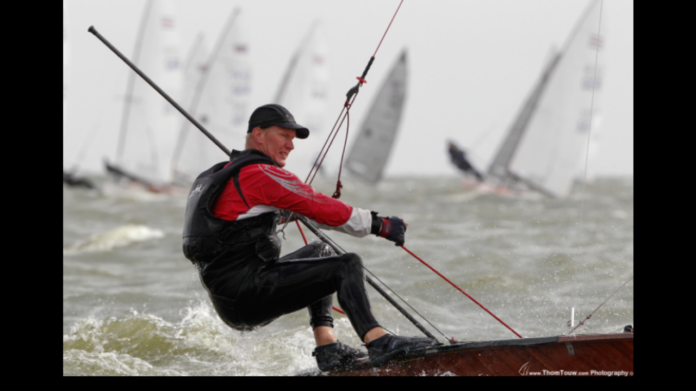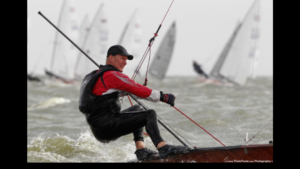

I have copied below excerpts from an interview I did with Mark Bulka on Mark Rounding – Planning and Placement.
Mark has won World, National and State championships in a number of different classes ranging from single handed monohulls through to catamarans.
On top of that he is an accomplished Ocean Racer and has competed in a number of Sydney to Hobart’s as sailing master.
His experiences and thousands of mark roundings have given him a unique insight into what it takes to effectively carry out this manoeuvre.
Brett: As you get close to the weather mark, I have heard you talk about where you don’t want to be..
Mark: I always called it the “death zone,” from the mark backwards and this area here in the last 400 meters is another area we just didn’t like to be.
It really gets ugly as people get spat out and start to come back, it just becomes this mixed up area, you’re ducking people and unless you right at the front it’s a pretty bad area.
Brett: in a big fleet, the air is even more disturbed and when you’re closer to the front of the fleet there are fewer boats, what do you do if you are deep in the fleet?. How far out do you plan your weather mark strategy?
Mark: It’s an evolving situation over time and there’s a lot of luck involved as well because you only need someone who doesn’t care about you so much to lamp on you at the right time.
Or perhaps it’s your mate coming across…he’s more likely to give you a little bit of breathing room. So there is a lot of luck involved and…
Brett: So what you’re saying it depends on the boats that are out there because it might be someone who you’re racing against for a regatta or a championship so they’re not going to give you any leeway at all. Whereas, it may be someone from your own club who might have a bit more respect and say, “We’ll look after Mark because he’ll look after me”.
Mark: Certainly at the Olympic level, it was a no go to ever tack on your…on anyone else in the front group.
It was a lot of respect amongst the sailors and they were happy to fight it out with shifts and not try to hammer you early on in a race anyway.
They would probably hammer you on the last beat if there was nothing in it but, you know, there was a friendly…because they know if you do it to them…
Brett: It’s going to come back.
Mark: It’s going to come back so it’s good to have as many friends on the water as possible so, you know, that’s really important as well.
Brett: Something we just spoke about before, how would you normally approach a weather mark if you find yourself well back in the mob in a big fleet? You said an interesting thing about, sometimes you’re better off coming in later on the port tack lay line perhaps.
Mark: If you’re back in the fleet obviously it’s pretty hard. There’s no magic trick all the way back up, but there are some things you can do that can pick up big numbers of boats.
One, don’t go to the starboard lay line. That will always lose you ground, I have never seen a starboard lay line work.
Perhaps if you’re on an A class cat which is accelerating…you know, accelerates by 50% of its speed by overlaying, but a boat like an Etchells which doesn’t actually accelerate at all you’re just guaranteed to lose heaps of ground
If you’re looking for a big pick up of places, the port lay line is actually your best chance to pick up a lot of places.
You can pick up 20 boats in a solid Etchells fleet just coming in on the port lay line, but as I said you’ve just got to be prepared to take a big duck at the end if there’s no hole.
You know it’s a risk. I think it works 80% of the time but, if it’s a really bunched up fleet and there’s no holes, you’ve got to be prepared to go back early.
Brett: Pretty good odds, 80%, isn’t it?
Mark: Yeah, the other way we would do it is the one thing I don’t want to do is come in…like I said, you don’t want to go on the starboard lay line but you don’t want to go underneath the starboard lay line and have a wall of boats either.
So I would always tack back when I knew I could still hold my air.
So if you’re in 10th place and there’s a bunch of boats already lobbed up on the starboard lay line, a bunch of boats on the port lay line, and you can’t obviously get right up. You tack before you lose your air on the starboard lay line.
So it might be 50 meters short of it, it might be 100 meters short of it. Whatever will still give you a lane of breeze getting across back towards the mark. So that’s one way I determine when to go back.
Obviously, if you’re 30th, then there’s no air. There’s boats coming from both sides. That’s a bad situation but there are less boats coming on the port lay line than the starboard lay line.
You’ve got more chance on the port lay line and again, this middle zone here it’s a terrible place to be. In a big one design of fleet there’s nothing going on here in the middle, upwind or downwind.
Brett: So what you’re saying is you got to make a choice as you’re approaching the weather mark. You make a choice whether you keep going back to end up on a port lay line, You don’t want to get in that death zone as you called it.
Mark: The death zone’s no good and the starboard lay line is the worst place ever, so.
Brett: It’s interesting when you’re seeing a big fleet you’ll notice that the guy’s right back get in the starboard tack parade. The further back they are, they end up sailing a hell of a lot of extra distance and they can’t dictate any terms at all. Everyone else dictates to them.
- Mark: And the boats on the starboard lay line are going so slow so a boat coming in with speed on the port side of the course will generally…you know, these guys will be squeezing, squeezing each other out and trying to stay high.
This guy will come in with so much more speed and maneuverability to be able to put himself in a position.
Brett: Because everyone’s guarding their position on the starboard tack lay line, they’re going higher and higher, trying to keep out of each other’s dirty air, and they’re going slow.
Mark: And the other thing is most of the boats on the starboard lay line, they’re often over the lay line so, the rule does allow the boat on Port to tack as long as they don’t cause the boats above to fetch. There’s actually a lot of opportunities to tack underneath just at the end.


